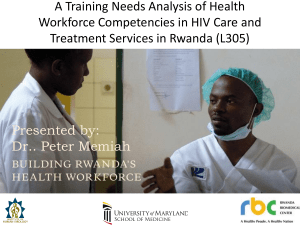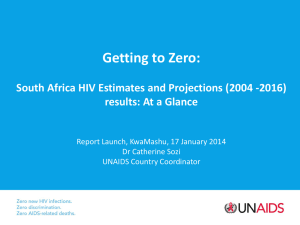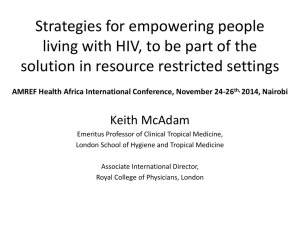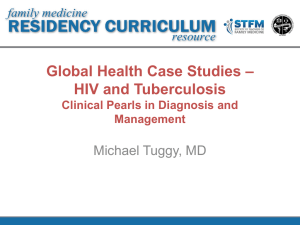HIV-Aids - International Federation for Emergency Medicine
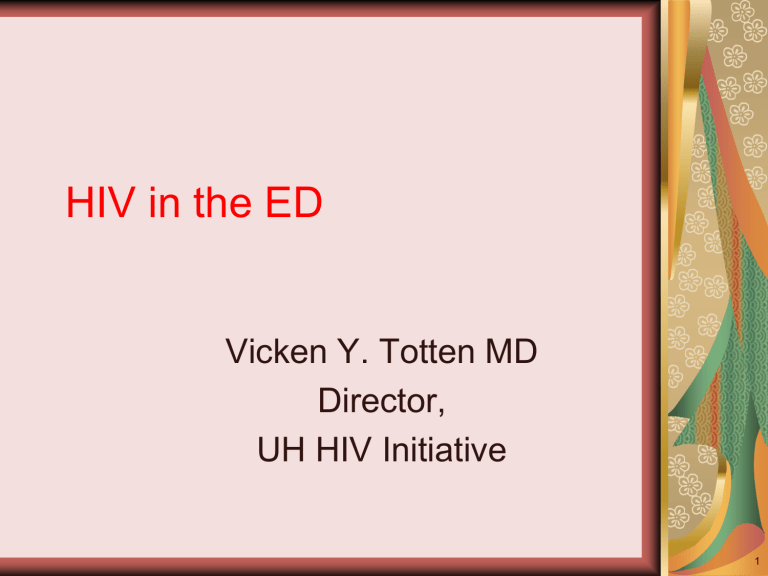
HIV in the ED
Vicken Y. Totten MD
Director,
UH HIV Initiative
1
Objectives
Define and discuss HIV: the virus & HIV: the infection
Discuss how HIV infection without AIDS manifests
Define and discuss AIDS, the disease
Discuss transmission and prevention
Describe the illnesses associated with HIV infection so you can recognize them and initiate treatment
Tell a brief history of ED-based HIV testing.
2
AIDS = Acquired Immune
Deficiency Syndrome
Acquired - because it's a condition one must acquire or get infected with, not something transmitted through the genes
Immune - because it affects the body's immune system, the part of the body which usually works to fight off germs such as bacteria and viruses
Deficiency - because it makes the immune system deficient
Syndrome - because someone with AIDS may experience a wide range of different diseases and opportunistic infections
3
What is HIV, the Virus?
Any of several retroviruses that infect and destroy helper T cells of the immune system
Most likely, a simian retrovirus
(Zoonosis)
4
The Human Immune Deficiency Virus
5
Two Kinds of Virus: HIV-1 vs.
HIV-2
HIV-1
More virulent
Responsible for worldwide epidemic
Severity of infection varies from person to person
HIV-1 likely descended from
SIV cpz
HIV-2
Primarily found in western Africa
Not transmitted as efficiently
Genome more closely related to
SIV mm than HIV-1
HIV-2 likely descended from
SIV sm
6
HIV, the Virus
RetroVirus: copies itself “backwards” from
RNA into the host DNA. Makes lots of errors leading to a high mutation rate
Targets macrophages, especially CD4 cells
Most infectious during the first viremic episodes. Requires “intimate contact” for transmission
Destroys the body’s ability to fight infections and certain cancers
Therefore, untreated patients infected with HIV are at risk for illness and death from:
Opportunistic infections
Neoplastic complications
7
History: When did the zoonosis jump species?
Three earliest known HIV infections
1959 - serum sample from a man in what is now the Democratic Republic of Congo
1969 - tissue from a St. Louis teen
1976 - tissue from a Norwegian Sailor
2000 - Dr. Bette Korber estimates SIV-> HIV occurred about 1930, based on computer modeling.
1979 The “HIV Epidemic” in the USA brought by
“patient 0”, a homosexual Canadian Airline Steward who was exceptionally sexually active wherever he flew.
8
Top HIV/AIDS-Infected Countries
Sub-Saharan
Africa
1.
South Africa
2.
Nigeria
3.
Zimbabwe
4.
Tanzania
5.
The Congo
6.
Ethiopia
7.
Kenya
8.
Mozambique
9.
10.
United
States
Russian
Federation
11.China
12.
13.
Brazil
Thailand
Source: Steinbrook R. The AIDS epidemic in 2004. NEJM.
2004;351:115-117.
9
Population Prevalence
One Baltimore inner city hospital found that up to 11% of patients had
HIV Antibodies
24% had either HIV or hepatitis B or
C.
Therefore, all contacts with patients’ blood or body secretions must be considered to be potentially infectious by ED personnel.
10
HIV Positives in our ED
2006, Radonich et al
Tested 666 samples of discarded blood from adult ED patients
2.5% sero-positivity.
Of these, 1 / 4 - 1 / 5 are not aware they are positive
STDs flock together. If you find an
STD, you should test for HIV
11
Proportion of AIDS Cases, by Race/Ethnicity
12
The Life Cycle of HIV-1
Structural Protein and
Enzyme Precursors
Viral
RNA
Viral
DNA
Viral
RNA
1. Binding and infection
2. Reverse transcription and integration of viral DNA
3. Transcription and translation
4. Modification and assembly
5. Budding and final assembly
13
HIV- Course of the infection
Inoculation: via internal contact, either thru a mucus membrane or into a body tissue
Window period: Before viral replication; after viremia but before immunologic response can be detected by RNA probes only
Antibody Tests positive: Saliva, blood, urine (?)
Asymptomatic: months to years
Symptomatic: Immune system cannot respond appropriately
Death
14
The Variable Course of HIV-1 Infection
Typical Progresser
Primary HIV
Infection Clinical Latency AIDS
Rapid Progresser
Primary HIV
Infection
AIDS
A months
B years
Nonprogressor
Primary HIV months
Infection Clinical Latency years
?
C months years
Reprinted with permission from Haynes. In: DeVita et al, eds. AIDS: Etiology, Treatment and Prevention .
4th ed. Lippincott-Raven Publishers; 1997:89-99.
15
HIV Hides in many organ systems
Colon, Duodenum and
Rectum Chromaffin Cells Brain Macrophages and Glial Cells
Lymphocytes in Blood,
Semen and Vaginal Fluid
Bone Marrow
Skin Langerhans’
Cells
Lymph Nodes
Thymus Gland
Lung Alveolar
Macrophages
16
Manifestations of HIV Infection
Primary Infection Clinical Latency Advanced Disease
“A Viral Syndrome” sore throat, fever, lymphadenopathy, rash
Asymptomatic; virus
“hides” in lymph nodes, thymus and bone marrow symptoms 1-6 weeks after infection differential includes
EBV, CMV, hepatitis, toxoplasmosis
Antibody (ELISA,
Western Blot) and Rapid
Test likely negative
Detect/test with RNA
PCR probles
Symptomatic
Plasma viremia begins to rise. CD4 cell count falls further Replicates and destroys
CD4 cells a decrease in lean body mass without apparent total body weight change
A decline in nutrient status or body composition, weight loss vitamin B12 deficiency increased susceptibility to food and water-borne pathogens.
Opportunistic infections : fever, lymphadenopathy, thrush, diarrhea, malignancies, wasting syndrome, neurologic syndrome including dementia
17
Leading Causes of Death in People
Aged 25-44 Years in the US (1983-
1998)
40
30 Unintentional injuries
Cancer
Deaths per
100,000
Population
20
Heart disease
Suicide
10
HIV infection
Homicide
Liver disease
Stroke
Diabetes
0
1984 1986 1988 1990 1992 1994 1996 1998
Year
Gallant J. Planning for Long-Term Success in HIV Management. Satellite Symposium to the
First IAS Conference on HIV Pathogenesis and Treatment, July 8 – 11, 2001.
18
Metabolic and morphologic complications associated with HIV.
Sounds a lot like aging, doesn’t it?
Metabolic
Glucose disorders
Morphologic insulin resistance impaired glucose tolerance hyperglycemia frank diabetes
Fat accumulation abdominal obesity buffalo hump lipomatosis breast enlargement gynecomastia Lipid elevations increased triglycerides increased cholesterol
Hyperlactatemia lactic acidosis
Fat loss appendices face buttocks
Bone disease
Osteopenia , osteoporosis , avascular necrosis
19
Morphologic Complications:
Peripheral Fat Loss (Lipoatrophy)
20
Morphologic Complications:
Central Fat Accumulation (Lipohypertrophy)
21
Natural History of Untreated HIV
Infection
22
Transmission and Prevention
“Intimate Contact” is a euphemism for
“direct non-keratinized live tissue to tissue contact”
Saliva and tears are wet and can have virus, but also have high levels of accompanying antibodies
Semen > vaginal fluid have high viral loads and not so many antibodies
The virus cannot penetrate keratinized skin or latex; it dies when dried.
23
Who spreads HIV?
Those who don’t know they are infected.
Most who are at risk don’t consider themselves at risk
“Traditional risk groups” get tested
Those who know they are infected and are not protecting their partners
Those with low viral loads are LESS infective but still infective
Knowingly infecting someone else is a criminal offense
24
Relative Amounts of HIV in Body
Fluids
Modes of Transmission: perinatal, parenteral, sex
High
Moderate blood/ serum body cavity fluids semen vaginal fluid
Low/Not
Detectable breast milk urine saliva feces sweat tears
25
Transmission and Prevention
IVDA or Blood / Blood product transfusions – direct inoculation
Transplantation (including corneas)
Semen into vagina – incomplete conversion per year in discordant couples
Semen into rectum – higher rate of conversion
Testing the “tissue donor” in window period may permit transmission
26
When does perinatal transmission occur?
Antenatal
Intrapartum
Breastfeeding
*above baseline
Lancet 340(8819):585
∼ 20%
∼ 80%
∼ 14%*
27
HIV Transmission Factors
AIDS / High Viral Load
STD / Exposure; open mucosa
Genital lesions
Frequency of unprotected sex
Lack of Circumcision
28
Who should be tested?
All pregnant women
Anyone presenting with an STD
Anyone with an unusual rash, mysterious febrile illness or unusual / opportunistic infection or cancer
Anyone with an unexpectedly low WBC
29
Screening for HIV infection
2006 CDC recommendations changed.
Why? Several year plateau in rate of new infections. The current new positives primarily are those who do not see themselves at risk
Who? All people who come to EDs should be screened yearly
All people in the US at least once.
30
Occupational Exposure Risk
RNs most often exposed
½ of emergency physicians reported > 1 /
2-year period.
0.3% chance for percutaneous exposure
0.09% for mucocutaneous splash exposure.
HIV transmission by health care workers to patients appears to be extremely rare.
31
Post-exposure Prophylaxis (PEP)
(1) type of exposure
(2) HIV status of the source
Separate recommendations for percutaneous vs mucus membrane or non-intact skin exposures.
Intact skin no indications for therapy
Deep percutaneous exposures; visible blood on a device, injuries sustained during placement of a catheter in a vein or artery; lower-risk percutaneous exposures are superficial or involve solid needles.
32
HIV Status of Source?
High-risk: symptomatic HIV infection,
AIDS, acute seroconversion, high viral load;
Low-risk sources asymptomatic HIV infection viral load of less than 1500 copies/mL
Test Source: Negative Rapid Test Results is adequate to withhold or discontinue therapy.
Consider acute HIV infection -> assay of HIV RNA levels.
33
Non-occupational Exposure
Rape with significant exposure <72 hours; source known to be HIVinfected
28-day HAART
34
PEP Regimen
Two-drug therapy options include zidovudine plus lamivudine (available as
Combivir), lamivudine plus stavudine, didanosine plus stavudine.
PEP should be initiated within hours.
PEP is 4 weeks, if tolerated.
Discontinue PEP if the source is HIVseronegative.
35
National Clinicians PEP Hotline providing 24-hour assistance,
CDC/University of California –San
Francisco (UCSF) (1-888-448-4911),
University of California at Los Angeles
(UCLA)'s online decision-making support webpage
(http://www.needlestick.mednet.ucla.e
du).
36
The diseases associated with HIV infections
Acute Retroviral Syndrome
Chronic Retroviral Infection ->
Chronic Inflammation & Decreased
Immunity
Opportunistic infections
Cancers
Other diseases of reduced immunity
37
Acute Retroviral Syndrome
Requires a high index of suspicion
May have fever, fatigue, rash, pharyngitis as most common symptoms
Duration usually <2 weeks, but …
Diff dx: infectious mononucleosis, secondary syphilis, acute hepatitis A or
B, roseola or other viral exanthems, toxoplasmosis
KEEP TESTING
38
Non-specific Rashes
39
Acute Retroviral Syndrome
Fever 80 – 90%
Fatigue 70 – 90%
Rash 40 – 80%
Headache 32 – 70%
Lymphadenopathy
40 – 70%
Pharyngitis 50 –
70%
Thrombocytopenia
Arthralgias 5 – 70%
Myalgia 50 – 70%
Night sweats - 50%
GI symptoms 30 – 60%
Aseptic meningitis -
24%
Oral/genital ulcers 5 –
20%
Lymphopenia
40
AIDS – the Disease, Defined
HIV + with a CD4 cell count that is or has been less than 200 cells/mm 3
HIV + with a CD4 percent below 14%.
HIV + and has or has had an AIDS defining illness such as PCP, toxoplasmosis, MAC, Kaposi’s
Sarcoma, etc. regardless of CD4 cell count
41
HIV-associated viral conditions
HIV wasting
HIV associated dementia
Progressive multifocal leukoencephalopathy
CD4+ lymphocyte count of <200 cells/microL
42
AIDS-DEFINING ILLNESSES (1)
HIV infection PLUS:
Cancers:
Invasive cervical cancer, Kaposi's sarcoma (an
Herpes virus infection), Burkett Lymphoma,
Primary Brain Lymphoma
Infections from symbiots
Candida of esophagus, trachea, or lungs
Herpes simplex: chronic ulcers >1 month's
Cryptosporidiosis, chronic intestinal (>1 month's duration)
43
AIDS defining illnesses (2)
LUNGS:
Recurrent bacterial pneumonia
Pneumocystis jiroveci pneumonia
Cryptococcosis, extrapulmonary
Histoplasmosis: disseminated or extrapulmonary
Lymphoid interstitial pneumonia or pulmonary lymphoid hyperplasia complex
44
AIDS defining illnesses (3)
Coccidioidomycosis: disseminated or extrapulmonary
Cytomegalovirus disease (other than liver, spleen, or nodes), older >1 month
Cytomegalovirus retinitis (with loss of vision)
Extra-pulmonary histoplasmosis
Salmonella septicemia, recurrent
Toxoplasmosis of brain, onset at age >1 month*
Atypical Infections: M. avium. M kansasii , M. TB
Extrapulmonary coccidioidomycosis
Recurrent Salmonellosis
45
Brief overview of treatment
Anti-Retroviral Drugs
Prophylaxis against chronic opportunistic infections.
Chronic suppression of illnesses
46
Highly Active Anti-Retroviral Therapy
HAART
Collective name given to the most effective HIV regimens
Medications must be taken daily
Take all each day or none,
Missing medications can cause problems
Why?
47
Classes of Drugs
Nucleoside analog reverse transcriptase inhibitors - NRTI
Nucleoside Reverse Transcriptase Inhibitors
Nucleotide Reverse Transcriptase Inhibitors
Non-nucleoside Reverse Transcriptase Inhibitors
(NNRTIs)
Non-nucleoside reverse transcriptase inhibitors - NNRTI
Protease inhibitors - PI
Entry inhibitors - EI
Fusion Inhibitors (one approved by FDA)
Integrase inhibitor - II
Each works by a different mechanism; best used in combinations:
48
Anti-retroviral Medications
Class: NRTI
Abacavir
Didanosine
ABC
DDI
Emtricitabine FTC
Lamivudine
Stavudine
Tenofovir
Zidovudine
3TC
D4T
TDF
ZDV
NNRTI
Delavirdine
Efavirenz
Nevirapine
DLV
EFV
NVP
Protease Inhibitors PI
Amprenavir APV
Atazanavir
Darunavir
ATV
DRV
Fosamprenavir FPV
Indinavir IDV
Lopinavir LPV
Nelfinavir
Ritonavir
Saquinavir hard gel tablet
Tipranavir
NFV
RTV
SQV
HGC
INV
TPV
49
Newer Classes
CCR5 - Coreceptor Antagonist
Maraviroc MVC
II - Integrase Inhibitor
Raltegravir RAL
FI - Fusion Inhibitor
Enfuvirtide T-20
50
Optimal Time to Start Will Change
Over Time as More Data Emerge
Factors Favoring
Later Initiation
Factors Favoring
Earlier Initiation
Long-term toxicities
- more prevalent
- more serious
Drug development stalls
More drugs
Better drugs
Better management of toxicities
51
Medication Side Effects
Anorexia
Sore/dry/painful mouth
Swallowing difficulties
Constipation/Diarrhea
Nausea/Vomiting/Altered Taste
Depression/Tiredness/Lethargy
52
Drug Reactions
Drug reactions are extremely common among HIV-infected patients.
They are on LOTS of nasty drugs
HIV-infected persons have more drug reactions to ALL / ANY drugs than uninfected persons.
Dermatologic reactions are particularly common.
Antimicrobial drugs frequently are implicated.
53
Adverse Drug Effects
Mitochondrial
Dysfunction
Lactic acidosis
Hepatic toxicity
Pancreatitis
Peripheral neuropathy
Metabolic abnormalities
Lipodystrophy
–Fat accumulation
–Lipoatrophy
Hyperlipidemia /
? Premature CAD
Hyperglycemia
Insulin resistance/DM
Bone disorders: osteoporosis and osteopenia
Hematologic
Complications
Bone marrow suppression
Allergic reactions
Hypersensitivity reactions
Skin rashes
54
HIV and Cardiac Disease
HIV infection causes chronic inflammation
The inflammation can cause
Encephalopathy, myocarditis,
Progressive multi-focal leukoencephalopathy
HIV is an independent risk for ASVD
Disorders of Lipid metabolism
Consider HIV an inflammation risk factor stronger than cigarette smoking.
55
HIV- Complications at CD4>500mm 3
Infectious
Acute retroviral syndrome
Candida vaginitis
Other
Generalized Lymph Adenopathy
Guillain-Barre (very rare)
Vague constitutional symptoms
56
HIV- Complications at CD4 200-500mm 3
Infectious
Pneumococcal pneumonia
TB
Herpes zoster
Kaposis sarcoma
Oral hairy leukoplakia (OHL)
Oropharyngeal candidiasis (thrush)
Non-Infectious
Cervical Ca
Lymphomas
ITP (Immune thrombocytopenic purpura)
57
White Tongue, ulcer on tonsillar pillar
58
Oropharyngeal Candidasis
Thrush limited to oropharynx
Esophagitis more serious usually
CD4<100
Odynophagia
Chest pain
Other causes of esophagitis
CMV (usually CD4<50)
Idiopathic ulceration (CD4<50)
59
Palatine Candida
60
Candidal esophagitis
61
Oral Hairy Leukoplakia
Caused by EBV
No treatment required
62
Hairy Leukoplakia
63
Opportunistic Infections
Viruses:
Varicella-Zoster Virus
Herpes Simplex Virus
Cytomegalovirus
Protozoa:
Coccidiosis
(Cryptosporidiosis,
Cyclosporiasis, and
Isosporiasis)
Toxoplasmosis
Leishmaniasis (not in the
U.S., but in Southern Europe and in many other parts of the world)
Chagas’ Disease
Malaria
Bacteria:
Mycobacterium Avium
Complex
Mycobacterium
Tuberculosis
Fungi:
Pneumocystis jirovenci
(carinii) Pneumonia
Candidiasis
Aspergillosis
Cryptococcosis
Histoplasmosis
Coccidioidomycosis
Microsporidiosis
64
65
Advanced HIV + Altered Mental
Status, Seizures, HA or Focal Signs
Blood Tests
Toxoplasma IgG
RPR/VDRL
Cryptococcal Ag
Focal lesion
Treat empirically for
Toxo encephalitis
CT scan with contrast or MRI
No focal lesion Atypical lesion
+ negative Toxo serology
Lumbar puncture Stereotactic biopsy
66
Toxoplasmosa gondii
an obligate, intracellular protozoan cysts ingested in undercooked meats usually infection is easily contained organisms can persist as cysts in multiple organs
CNS disease is the most common manifestation if not on prophylaxis, at least 30% of patients with Toxo Ab will develop toxo encephalitits
67
Toxoplasmosis: clinical presentation
headache, confusion/altered mental status, and fever are the presenting complaints in
~ 50% of patients with intracerebral toxo
50-60% will have focal neurological signs
30% will have seizures can also present as chorioretinitis liver, lung & muscle involvement possible
68
Toxoplasmosis: diagnosis
Toxo serology - seropositivity to T. gondi in
HIV infected persons in the US ranges from 8 - >25%
97 - 99% of patients with AIDS and toxo have positive serologies (IgG)
Head CT/MRI - often multiple lesions, typically in brain stem, basal ganglia, corticomedulary junction
Biopsy - showing tachyzoites in tissue gives definitive diagnosis, but is often not required
69
Cerebral
Toxoplasmoma
70
Toxoplasmosis: treatment & prophylaxis
Optimal treatment: Pyramethamine + sulfadiazine or clindamycin
Alternative treatment: TMP/SMX
Optimal prophylaxis: TMP/SMX
Alternative proph: dapsone + pyramethamine
Prophylaxis required for CD4 ct < 100 if
Toxo IgG positive
71
Cryptococcus neoformans
ubiquitous encapsulated yeast, present in soil inhaled, ingested by alvoelar macrophages, escapes the lung cryptococcemia meningeal seeding
75% of cases occur when the CD4 count is
< 50 subacute course with headache and fever progresses to altered mental status, coma and death if untreated can present with focal neurologic deficit
72
Cryptococcus neoformans
high CSF protein and opening pressure diagnosis can be inferred by detection of cryptococcal capsular antigen (CrAg) in serum (positive in 95-99% of patients with meningitis) or CSF (sensitivity/specificity
93-100%/93-98%) treatment: amphotericin B +/- 5-flucytosine followed by fluconazole completion and fluconazole life-long maintenance therapy; can start with fluconazole if mild disease
73
Crypotococci
74
Pneumocystis
Fungus (mRNA sequence, enzyme structure, cell wall consistent with) vs. protozoa (morphology and response to pentamadine) found almost exclusively in the lungs of compromised hosts; has never been successfully cultured typically seen at CD4 ct < 200 usually presents as pulmonary dysfunction
- extrapulmonary/disseminated disease is rare
75
Pneumocystis
Pneumocystis carinii changed its name to
Pneumocystis jiroveci
(pronounced “yee row vet zee” & named after the Czech pathologist Otto Jirovec)
76
Should I treat for PCP in this HIV patient with pneumonia??
Cough > 7 d
DOE
LDH > 400 pO2 < 75 interstitial infiltrate
PCP
50%
81%
62%
66%
69%
Bacterial
20%
43%
29%
36%
17%
77
Pneumocystis carinii
Diagnosis: induced sputum (using hypertonic saline) or bronchoscopy/BAL
(sputum induction 75-80+% sensitivity, BAL
95-99% sensitivity)
Treatment: TMP/SMX
Alternative therapy: trimethoprim + dapsone, atovaquone, clindamycin + primaquine, pentamadine IV
Prednisone: adjunctive therapy if PO2 <
70mmHg
78
Pneumocystis carinii prophylaxis
if CD4 ct < 200 may stop after CD4 ct > 200 for 3-6 months first choice: TMP/SMX M-W-F (QD if
CD4 ct < 100 & Toxo Ab positive) alternatives: dapsone, atovaquone, aerosolized pentamadine
79
Diarrhea in HIV patient
History
Antibiotic exposure
Gay male or traveler
Seafood exposure
Concomitant
Proctitis
C. diff. toxin O & P r/o
Giardia &
E. histolytica
Vibrio
Cx gonorrhea
Chlamydia
HSV syphilis
80
Chronic diarrhea in HIV patient
CD4 count
MAC
10-20%
AFB Blood culture
< 50 viruses
(esp. CMV)
10-40%
Microsporidia
15-20% biopsy trichrome stain of stool
< 100 stool AFB or DFA
< 200
Isospora
1-2%
Cryptosporidium
20-30% stool AFB or DFA
81
Mycobacterium Avium Complex
found free in the natural environment transmission via inhalation, aspiration or ingestion signs/symptoms: fever, nightsweats, weight loss, diarrhea, malabsorption, focal lymphadenitis, hepatosplenomegaly pancytopenia, increased alkaline phosphatase progressive deterioration and death in 2 - 6 months is the rule if untreated
82
Mycobacterium Avium Complex
Treatment: effective drugs include ethambutol, clarithromycin, azithromycin, rifabutin, ciprofloxacin, ofloxacin, and amikacin typically 3 (at least 2) agents are used to prevent the emergence of resistance
Primary prophylaxis when CD4 < 50
Clarythromycin (500 mg BID) or azithromycin (1250 mg Q week) are the preferred agents for prophylaxis
83
Other Opportunistic Infections
The 4 H’s :
HCV - 40 % co-infected, highest in IVDU
Human CMV - recent decline in incidence
HHV-8 Kaposi’s Sarcoma
HPV
Lymphomas (autoimmune phenomena)
Rhodococcus
84
Opportunistic Infections (O.I.s’)
Occur only when immuno-suppressed
Increases with decreasing CD4 count
Available medications for prophylaxis
Examples
PCP, Toxoplasmosis, MAC, etc
Increase chance of complications and death
85
Kaposi’s Sarcoma
Clinical manifestations variable in HIV
Usually cutaneous or oral but visceral involvement also occurs (GI, respiratory tract)
Causative organism human herpes virus 8 (HHV-8)
86
p o s i’ s
K a
87
Presentation of Kaposi's sarcoma
88
Presentation of Kaposi's sarcoma
89
HIV- Complications at CD4 < 200mm 3
Infectious
PCP
Histoplasmosis (other endemic fungi)
Miliary TB
PML
Non-Infectious
Wasting
Peripheral neuropathy
Cardiomyopathy
Dementia
90
Pneumocystis carinii pneumonia
Variable presentations
Pneumocystis carinii changed to Pneumocystis jiroveci
20-40% in patients not on HIV rx
Usually subacute presentation of dry cough, dyspnea
CXR typically reveals interstitial infiltrates
May have lobar consolidation
Pneumothorax in severe cases
Treatment/ prophylaxis
91
Pneumocystis jiroveckii (carinii) pneumonia aka PCP
92
Diagnosis of Pneumocystis carinii
93
Histoplasma
Mississippi River Delta
Rarer in SC
Wide spectrum of illness from acute sepsis like syndrome to acute pneumonia to cutaneous involvement
94
Oral lesions of disseminated Histoplasma capsulatum infection
95
Progressive Multifocal
Leukoencephalopathy (PML)
Clinical disease occurs in patients with advanced disease and onset may be insidious, over several weeks.
Clinical signs and symptoms include hemiparesis (43%), cognitive defects (22%), speech deficits (28%),visual deficits (16%), sensory deficits (14%), and seizures (5%).
96
Progressive Multifocal
Leukoencephalopathy (PML)
Clinical hallmark of disease is patient with focal neurologic defect, white matter disease and no mass effect. Lesions do not enhance on imaging
PML is a demyelinating disease of the central nervous system caused by infection of oligodendrocytes by JCV, a papovavirus.
97
Progressive Multifocal Leukoencephalopathy
98
Progressive Multifocal
Leukoencephalopathy
99
HIV- Complications at CD4 < 100mm 3
Infectious
Disseminated HSV
Toxoplasmosis
Candida esophagitis
Cryptosporidiosis, microsporidiosis, isospora
Cryptococcal disease
100
Cryptococcal Meningitis
C. neoformans is an encapsulated yeast, inhaled into the small airways where it usually causes sub-clinical disease; dissemination to the CNS is not related to pulmonary response.
C. neoformans produces no toxins and evokes little inflammatory response. The main virulence factor is the capsule.
101
Cryptococcal Meningitis
Clinical manifestations: headache (70-90%), fever (60-80%), malaise (76%), stiff neck (20-30%), photophobia (6-18%), seizures (5-10%) nausea.
Average duration of symptoms is 30 days.
Predictors of poor outcomes are altered mental status, increased opening pressure,
WBC<20 cells/mm3.
102
Cryptococcal Meningitis
Diagnosis made by CSF examination with india ink (74-88%), Crypto Ag serum/CSF
(99%), CSF culture.
Level of Crypto Ag is not indicative of severity of disease or a marker of response to therapy. Serum Crypto Ag can rule out clinical disease in HIV positive but not negative patients.
103
Cryptococcus neoformans
104
Toxoplasmic Encephalitis
Clinical presentation includes focal neurologic deficit (50-89%), seizures (15-
20%), fever (56%), generalized cerebral dysfunction, neuropsychiatric abnormalities.
Diagnosis is often presumptive based on characteristic lesions, clinical course, risk strata and positive serology.
105
Toxoplasmic Encephalitis
Presumptive diagnosis is considered confirmed by tissue sample or response to
TOXO therapy in appropriate time frame.
Patients should show clinical response -neuro deficits, not necessarily fever or headache -- by day 5 (50%), day 7 (70%), and day 14 (90%). In contrast, patients with CNS lymphoma all had worsening of signs or symptoms by day 10 of therapy.
106
Cerebral toxoplasmosis
107
Cryptosporidium parvum
108
Cryptosporidial organisms
109
Isospora belli
110
HIV- Complications at CD4 < 50mm 3
Infectious
Disseminated CMV/Retinitis
Disseminated MAC
Non-Infectious
CNS Lymphoma
111
Disseminated MAC
Usually a sub-acute/chronic illness characterized by fevers, weight loss, diarrhea, night sweats, wasting
CD4<50
112
Mycobacterium avium-intracellulare
113
Primary CNS Lymphoma
B-cell malignancies, high-grade (73%).
Occurs in extremely immunocompromised hosts (CD4 < 50 cells/mm3), unlike systemic NHL.
Common signs include focal neuro deficits
(38-78%), altered sensorium (57%), seizures (21%), cranial nerve defects
(13%).
114
Primary CNS Lymphoma
50% of patients will have single lesions, usually in the gray matter.
Toxo lesions are usually multiple, smaller and associated with basal ganglia but the two entities cannot be distinguished by imaging alone.
115
Primary CNS Lymphoma
Diagnosis is based on clinical presentation, neuroimaging, CSF studies, and brain biopsy.
CSF PCR for EBV is sensitive (66-99%) and specific (60-99%).
Treatment is radiation +/- chemotherapy.
Response is related to stage of disease and control of HIV.
116
Primary central nervous system lymphoma
117
Cytomegalovirus Retinitis
118
Summary of OIs for Which
Prevention Is Recommended
Primary Prophylaxis
Pneumocystis jiroveci pneumonia (PCP)*
Tuberculosis*
Toxoplasmosis*
Mycobacterium avium complex (MAC)*
Varicella-zoster*
S pneumoniae infections †
Hepatitis A and B †
Influenza †
* Standard of care
† Generally recommended
119
Summary of OIs for Which
Prevention Is Recommended
Secondary Prophylaxis
Pneumocystis jiroveci pneumonia (PCP)*
Toxoplasmosis*
Mycobacterium avium complex (MAC)*
Cryptococcosis*
Histoplasmosis*
Coccidioidomycosis*
Cytomegalovirus*
Salmonella bacteremia
†
* Standard of care
† Generally recommended
120
OIs for Which Prevention Is Not
Routinely Indicated
Primary Prophylaxis
Bacteria
(neutropenia)
†
Cryptococcosis †
Histoplasmosis
†
Cytomegalovirus †
Secondary
Prophylaxis
Herpes simplex virus
§
Candida §
† Evidence for efficacy but not routinely indicated
§ Recommended only if subsequent episodes are frequent or severe
121
Agent
PCP
Toxo
MAC
Indications for Possible Discontinuation of
Primary and Secondary Prophylaxis
Recommendation
(only for patients on effective ART)
Primary: CD4 >200 cells/µL for 3 months
Secondary: CD4 >200 cells/µL for 3 months
Primary: CD4 >200 cells/µL for 3 months
Secondary: CD4 >200 cells/µL for 6 months + initial toxo treatment + asymptomatic
Primary: CD4 >100 cells/µL for 3 months
Secondary: CD4 >100 cells/µL for 6 months + 12 months
122
MAC treatment + asymptomatic
